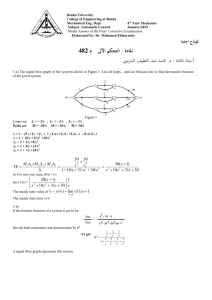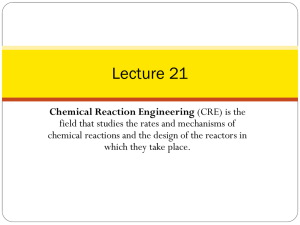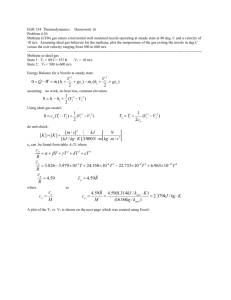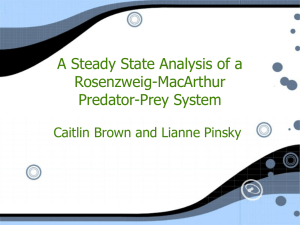Geology
advertisement
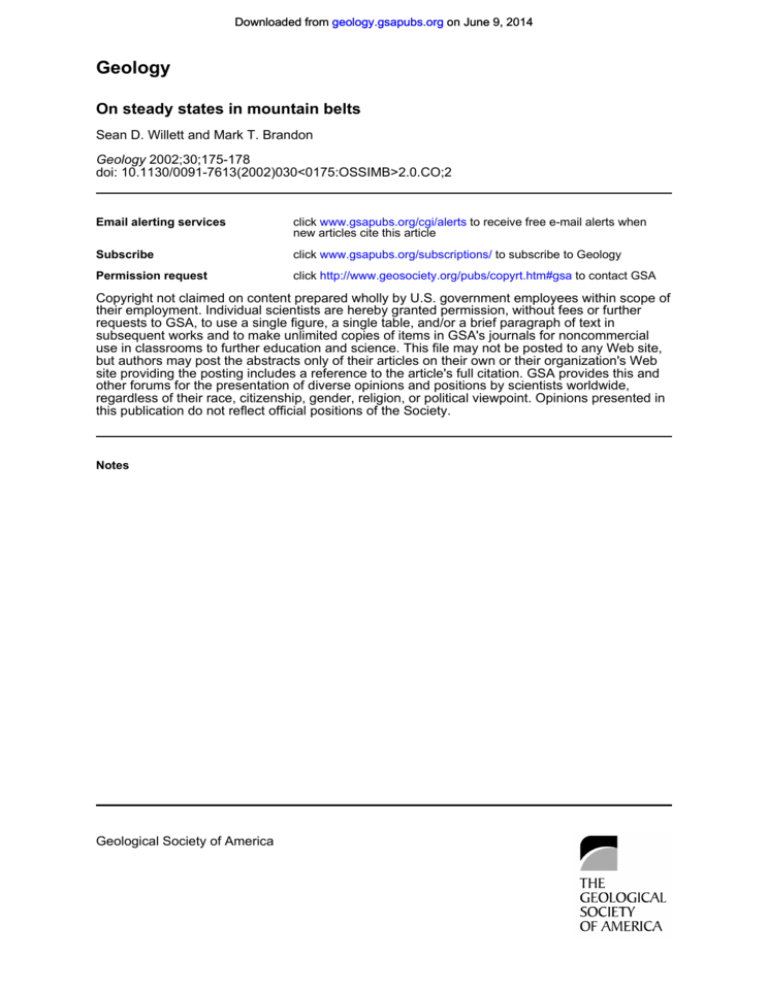
Downloaded from geology.gsapubs.org on June 9, 2014 Geology On steady states in mountain belts Sean D. Willett and Mark T. Brandon Geology 2002;30;175-178 doi: 10.1130/0091-7613(2002)030<0175:OSSIMB>2.0.CO;2 Email alerting services click www.gsapubs.org/cgi/alerts to receive free e-mail alerts when new articles cite this article Subscribe click www.gsapubs.org/subscriptions/ to subscribe to Geology Permission request click http://www.geosociety.org/pubs/copyrt.htm#gsa to contact GSA Copyright not claimed on content prepared wholly by U.S. government employees within scope of their employment. Individual scientists are hereby granted permission, without fees or further requests to GSA, to use a single figure, a single table, and/or a brief paragraph of text in subsequent works and to make unlimited copies of items in GSA's journals for noncommercial use in classrooms to further education and science. This file may not be posted to any Web site, but authors may post the abstracts only of their articles on their own or their organization's Web site providing the posting includes a reference to the article's full citation. GSA provides this and other forums for the presentation of diverse opinions and positions by scientists worldwide, regardless of their race, citizenship, gender, religion, or political viewpoint. Opinions presented in this publication do not reflect official positions of the Society. Notes Geological Society of America Downloaded from geology.gsapubs.org on June 9, 2014 On steady states in mountain belts Sean D. Willett Department of Earth and Space Sciences, University of Washington, Seattle, Washington, 98195, USA Mark T. Brandon Department of Geology and Geophysics, Yale University, New Haven, Connecticut 06520, USA ABSTRACT The dynamic system of tectonics and erosion contains important feedback mechanisms such that orogenic systems tend toward a steady state. This concept is often invoked, but the nature of the steady state is commonly not specified. We identify four types of steady state that characterize the orogenic system and illustrate these cases by using numerical-model results and natural examples. These types are (1) flux steady state, (2) topographic steady state, (3) thermal steady state, and (4) exhumational steady state: they refer to the erosional flux, the topography, the subsurface temperature field, and the spatial pattern of cooling ages, respectively. Models suggest that the topography will reach a steady mean form at the scale of an orogenic belt, but perfect topographic steady state is unlikely to be achieved at shorter length scales. Thermal steady state is a precondition for exhumational steady state and in the case of temperature-dependent deformation, topographic steady state. Exhumational steady state is characterized by reset age zones spatially nested according to closure temperature, as illustrated in natural systems from New Zealand, the Cascadia accretionary margin, and Taiwan. Keywords: orogeny, exhumation, fission-track dating, landscape evolution, steady-state processes. INTRODUCTION The high elevation of active convergent mountain belts represents a balance between the tectonic processes that create topography and the erosional surface processes that destroy it. This orogenic system represents a dynamic system with negative feedback, such that the system tends toward a stable or steady state (Adams, 1980; Jamieson and Beaumont, 1988). Foremost among these feedback mechanisms is the dependence of erosion rate on relief and elevation. Increased relief in mountain belts leads to enhanced erosion through the relief dependence of major erosional mechanisms such as fluvial incision and mass wasting (Ahnert, 1970). Increased elevation leads to higher erosion rates by orographically enhancing precipitation rates (Barry, 1981) and by permitting the development of alpine glaciers (Hallet et al., 1996). Geomorphologists have long recognized the importance of erosional feedback. The recognition of steady landforms, such as graded river channels, can be traced to Gilbert (1877), and by the 1970s concepts of steady or equilibrium landforms became widely accepted (Hack, 1960; Chorley, 1962; Schumm and Lichty, 1965; Penck, 1953; Howard, 1965, 1982). The importance of time and space scales to the stability of landforms, as well as overuse of equilibrium, led to some confusion with terminology (Howard, 1988; Phillips, 1992). Nonetheless, the important hypothesis emerged that steady-state landforms are indicative of steady tectonic uplift (Hack, 1976), although the ability of a system to reach steady state depends on the system response time to tectonic or climatic change (Howard, 1982; Kooi and Beaumont, 1996; Whipple, 2001). With knowledge of the thermal state of the crust, important constraints on erosion rates and the stability of landforms are available from low-temperature thermochronometers, such as fission-track dating of apatite and zircon (Gleadow and Brown, 2000) and U-Th/He dating of apatite (Farley, 2000). Constant erosion rates determined over different age ranges from independent thermochronometers or single thermochronometers distributed in elevation can be interpreted as representative of one type of steady state (Brandon et al., 1998; Batt et al., 2000; Gleadow and Brown, 2000). Steady states for topography and erosional processes are important because these represent the stable states toward which the dynamic tectonic-erosion system evolves. In addition, many modeling studies are developed in the context of a steady state (Koons, 1989; Stuwe et al., 1994). Even if a mountain belt never reaches a steady state, the degree to which it approaches steady state provides a measure of its maturity. To fully exploit these principles, we must address two interrelated questions regarding the characteristics of steady-state systems. First, how do we define and recognize steady state in terms of topography, cooling ages, or other measures of erosion in mountain belts? Second, what are the space- and time-scale dependencies, or interdependencies of various steady states? We address these questions by presenting a model for the space and time evolution of topography and cooling ages exposed at Earth’s surface in a convergent orogenic mountain belt. Our model is based on numerical models of coupled crustal deformation, landscape evolution, and erosion, details of which were presented elsewhere (Willett, 1999; Willett et al., 2001); we focus here on concepts, definitions, and intuitive understanding of the orogenic system. CONVERGENT OROGEN MODEL Although the concept of a steady-state topography is applicable to the full range of tectonic settings, in this paper we restrict our analysis to convergent orogenic belts, where there is a strong feedback between the high rates of rock uplift and erosion. We assume that the process of orogenesis is described by a model of crustal accretion associated with plate subduction (Fig. 1). Material accreted from the subducting plate can consist of sediment or continental crustal basement, depending on the tectonic setting. The important characteristic is that crustal deformation is driven by a mass flux FA (Fig. 1) of material from the pro-plate (left in Fig. 1) into the orogen (right in Fig. 1). During convergent orogenesis, a positive accretionary flux, FA, leads to surface uplift and an increase in erosional flux, FE. As these fluxes approach equality, physical characteristics of the system approach steady values. q 2002 Geological Society of America. For permission to copy, contact Copyright Permissions, GSA, or editing@geosociety.org. Geology; February 2002; v. 30; no. 2; p. 175–178; 3 figures. 175 Downloaded from geology.gsapubs.org on June 9, 2014 Figure 1. Kinematic model for convergent orogen, driven by plate subduction and accretion. Accretionary flux, FA, and erosional flux, FE, determine material transport (dashed lines), with vertical and horizontal components u and v, respectively. Upper illustrations show topography predicted from surface-process model driven by constant tectonic uplift and constant horizontal shortening rate. Rightmost upper illustration is in topographic steady state as defined by mean cross-sectional form. STEADY STATES Flux Steady State The simplest form of steady state occurs when the accretionary flux FA equals the erosional flux FE (Fig. 1), a condition that we call flux steady state (Brandon et al., 1998). A steady erosional flux can be used to infer a constant mean erosion rate and thus steady topography, but this need not be the case, because the form of the landscape could vary while the erosional flux remained steady. Erosional fluxes commonly show short-term temporal variations, due to local erosional events (e.g., storms, landslides) or to climate cycles, whereas the longterm erosional flux, on a time scale of 1 m.y., is more relevant to the evolution of the orogenic system. Topographic Steady State In a strict sense, topographic steady state defines the condition that the elevation of Earth’s surface at all spatial points within a domain of interest does not change with time. In practice, topographic steady state is likely to be met only for a limited set of topographic features. For example, one might refer to steadiness in the mean or maximum elevation of the orogen, or in the longest wavelength of the topography. Topographic steady state has been illustrated by using landscape evolution models (Kooi and Beaumont, 1996; Braun and Sambridge, 1997; Densmore et al., 1998; Willett et al., 2001), an example of which is shown in Figure 1. In this model, surface uplift is generated by a specified tectonic velocity function with a vertical component (i.e., rock uplift rate) constant across the section and a horizontal component increasing linearly from right to left. The surface is eroded according to a set of physical rules simulating the geomorphic processes of fluvial incision and hillslope diffusion. These relationships specify mass fluxes that depend on local topographic slopes and local fluvial discharge. With constant rates of tectonic uplift and precipitation, and no horizontal velocity gradients, these models evolve to a full topographic steady state (Kooi and Beaumont, 1996). However, including horizontal shortening changes the necessary condition for steady state to 176 Figure 2. Evolution to exhumational steady state for thermochronometers. A: Surface pattern of ages from multiple thermochronometers at exhumational steady state. Note nested zones of reset ages against retro–deformation front. B: Time (t) evolution of surface ages from thermochronometer A with closure temperature TA assuming constant preorogenic age. C: Particle paths and closure isotherms. ]h ]h 5 u 2 ė 2 v 5 0, ]t ]x (1) where h is the elevation as a function of distance x, and time t, u is the rock uplift rate at the surface, ė is the local erosion rate, and v is the rock velocity in the horizontal (x) direction. To achieve topographic steady state, local erosion must balance both the rock uplift and the horizontal advection of the topography (last term in equation 1), a condition nearly impossible to achieve as slopes change dramatically in magnitude and orientation with no comparable change in uplift or erosion rate (Willett et al., 2001). However, the average cross-sectional form of the topography, including characteristics such as the mean elevation and the height of the main divide, can reach a steady value. Geomorphic processes are also intrinsically unsteady, especially at local scale lengths, as illustrated by landsliding, meandering of rivers, and short-lived aggradational events in otherwise bedrock rivers. Thus, we expect that full topographic steady state is probably never achieved. Thermal Steady State The subsurface temperature field of an orogen will change with time as a function of the internal velocity field and erosion (Fig. 2C). Thermal steady state refers to a time-invariant temperature field. Thermal steady state must occur before the deformation field can become steady, given that rocks have a temperature-dependent rheology. The temperature field cannot reach steady state until the velocity field reaches steady state because of advective heat transfer. Topographic GEOLOGY, February 2002 Downloaded from geology.gsapubs.org on June 9, 2014 steady state and the surface distribution of thermochronometric ages depend on temperature and thus thermal steady state. These interrelationships highlight coupling mechanisms in the dynamic orogenic system. Exhumational Steady State To evaluate the time dependence of erosion rates over geologic time, geologists tend to rely on low-temperature thermochronometers such as 40Ar-39Ar, fission-track, and (U-Th)/He dating to infer exhumation rates. If ages obtained from a specific thermochronometer within a specified spatial domain are time invariant, we refer to this as exhumational steady state. Thus, there will be an independent exhumational steady state for independent thermochronometers. Note that this definition is not limited to thermochronometers; any material property that retains burial information, such as a metamorphic geobarometer or metamorphic assemblage, has the potential to reach steady state. The spatial pattern of exhumation is determined by the particle paths followed by rocks through the orogen to the surface. In a convergent orogen, particle paths are dominated by the accretion process (Fig. 2C). New material is accreted from the left in Figure 2C, transits the orogen, and leaves the system by erosion. In the initial stages of development, erosion will be insufficient to expose reset thermochronometers, and therefore surface rocks will have ages reflecting a preorogenic thermal history (Fig. 2B, t1, t2). Once erosion is sufficient to exhume reset thermochronometers, the cooling ages will reflect synorogenic temperatures and exhumation rates (Fig. 2B, t3). Ultimately, if exhumation rates are steady, then the pattern of reset ages will tend to become constant with time, although not necessarily spatially uniform (Fig. 2, A and B). A prediction of this model is that, at steady state, thermochronometers will show nested reset zones, organized according to closure temperature, the highest closure temperature being in the center. Asymmetric offset of the reset zones reflects polarity of accretion. The ages within the reset-age zones will vary with thermochronometer, reflecting the greater depth to the higher closure temperature (Fig. 2C), and spatially reflecting the kinematic path and the temperature field. DISCUSSION AND NATURAL EXAMPLES Exhumational steady state is an important indication of the maturity of an orogen. However, it is difficult to directly determine steadiness of an exhumational indicator because it requires measurements made over a range of geologic time. This condition can be met with a high-resolution stratigraphic record containing datable minerals deposited over an extended time interval, although one must establish that the source region for the dated sediment has remained constant with time (Cerveny et al., 1988; Bernet et al., 2001). The spatial distribution of one or more thermochronometers can also yield important insight into the maturity of an orogen. For example, Figure 3A shows the distribution of ages from three thermochronometers across the active Southern Alps of New Zealand. Reset K-Ar ages from muscovite (closure temperature of ;350 8C) are restricted to a zone within the zircon fission-track (closure temperature of ;240 8C) reset-age zone, which in turn is within the apatite reset-age zone (closure temperature of ;115 8C). All reset-age zones are offset to the western margin of the orogen. From these observations, we can infer that accretion and erosion are responsible for east to west kinematic transport. Furthermore, modeling the width and position of the reset-age zones suggests that the system is likely to be close to or at exhumational steady state (Batt and Braun, 1999). The Cascadia wedge in northwestern Washington State shows a similar nested pattern of reset zones (Brandon et al., 1998) (Fig. 3B). The reset zones are offset to the northeast, in the direction of plate convergence. Batt et al. (2001) argued that the orogen has been in a flux steady state since 15 Ma; ages from the central part of the orogen GEOLOGY, February 2002 Figure 3. Thermochronometric ages from three active orogens, plotted as distance from retro–deformation front such that material is accreted from left. See Figure 2 for orientation of data relative to particle paths. A: Ages from Southern Alps of New Zealand (Batt et al., 2000). K-Ar ages from muscovite, zircon fission-track (ZFT) and apatite fission-track (AFT) ages are plotted according to their distance east of Alpine fault. B: Ages from three thermochronometers from Olympic Mountains of Washington State (Batt et al., 2001). Unreset ages older than 30 Ma have not been plotted. C: Zircon fissiontrack ages from Taiwan. Data from Liu et al. (2001) are projected onto four east-west profiles located 40 km (solid squares), 120 km (solid circles), 200 km (open squares), and 250 km (open circles) from southern tip of Taiwan and plotted as distance from retro–deformation front. 177 Downloaded from geology.gsapubs.org on June 9, 2014 have reached steady values, as indicated by steady exhumation rates inferred from different thermochronometers. However, reset ages are limited to the core of the range. With time, the reset-age zones should expand to reach the northeast margin of the orogen. Only then will the full orogen be in an exhumational steady state. Another example of an active orogenic system tending toward steady state is provided by the arc-continent collision currently occurring in Taiwan. The collision zone has been interpreted as being in topographic steady state (Suppe, 1981) on the basis of the constant width and height of the range for 250 km along its most northern extent. Taiwan has the important characteristic that the collision is occurring obliquely, so that it is progressively younger to the south. We can use this space-time equivalence to interpret spatially distributed data in terms of time evolution. Liu et al. (2001) reported zircon fission-track ages across the main range of Taiwan. Figure 3C shows a subset of their data projected onto four profiles crossing the Taiwan orogen. Samples on the southernmost profile are all unreset; the more northern profiles show reset zircon fission-track ages in a zone adjacent to the eastern mountain front. As predicted by the model in Figure 2, the reset-age zone widens to the north, i.e., with increasing time. The zircon fission-track ages are consistent with west to east subduction, accretion, and shortening. The youngest ages are younger than 2 Ma and do not vary systematically along the eastern front of the range, suggesting that this region is in exhumational steady state. However, the monotonic widening of the resetage zone suggests that the full orogen is still approaching exhumational steady state for zircon fission-track ages. SUMMARY The concept of a topographic steady state is a useful concept at the space and time scales appropriate to the evolution of an entire orogenic belt, provided an appropriate characteristic of the topographic field is specified. The sediment flux from an orogenic belt is one important indication of topographic steady state, but is not a direct measure of topography and thus should be differentiated as a flux steady state. Steadiness of thermochronometric ages at spatial points within an orogenic belt is an indication of maturity of an orogenic system and is worthy of the independent term of exhumational steady state. It is only meaningful to consider steadiness of reset thermochronometers, which, at steady state, will be spatially contained in a zone determined by particle paths internal to the orogen. The prediction of subduction-driven orogenic models is that reset-age zones will be nested adjacent to the retro–deformation front. The degree to which this pattern is developed provides an important measure of the maturity of an orogenic system. ACKNOWLEDGMENTS This paper was supported in part by National Science Foundation grant EAR-9526954 to Willett. This manuscript was improved by constructive reviews by Doug Burbank, Kelin Whipple, and an anonymous reader. REFERENCES CITED Adams, J., 1980, Contemporary uplift and erosion of the Southern Alps, New Zealand: Geological Society of America Bulletin, v. 91, p. 1–114. Ahnert, F., 1970, Functional relationships between denudation, relief, and uplift in large mid-latitude drainage basins: American Journal of Science, v. 268, p. 243–263. Barry, R.G., 1981, Mountain weather and climate: London, Methuen, 313 p. Batt, G.E., and Braun, J., 1999, The tectonic evolution of the Southern Alps, New Zealand: Insights from fully thermally coupled models dynamical modeling: Geophysical Journal International, v. 136, p. 403–420. Batt, G.E., Braun, J., Kohn, B.P., and McDougal, I., 2000, Thermochronological analysis of the dynamics of the Southern Alps, New Zealand: Geological Society of America Bulletin, v. 112, p. 250–266. Batt, G.E., Brandon, M.T., Farley, K.A., and Roden-Tice, M., 2001, Tectonic synthesis of the Olympic Mountains segment of the Cascadia wedge, using 2-D thermal and kinematic modeling of isotopic ages: Journal of Geophysical Research (in press). Bernet, M., Zattin, M., Garver, J.I., Brandon, M.T., and Vance, J.A., 2001, Steady-state exhumation of the European Alps: Geology, v. 29, p. 35–38. 178 Brandon, M.T., Roden-Tice, M.K., and Garver, J.I., 1998, Late Cenozoic exhumation of the Cascadia accretionary wedge in the Olympic Mountains, NW Washington State: Geological Society of America Bulletin, v. 110, p. 985–1009. Braun, J., and Sambridge, M., 1997, Modelling landscape evolution on geological time scales: A new method based on irregular spatial discretization: Basin Research, v. 9, p. 27–52. Cerveny, P.F., Naeser, N.D., Zeitler, P.K., Naeser, C.W., and Johnson, N.M., 1988, History of uplift and relief of the Himalaya during the past 18 million years: Evidence from fission-track ages of detrital zircons from sandstones of the Siwalik group, in Kleinspehn, K.L., and Paola, C., eds., New perspectives in basin analysis: New York, Springer-Verlag, p. 43–61. Chorley, R.J., 1962, Geomorphology and general systems theory: U.S. Geological Survey Professional Paper 500-B, p. B1–B10. Densmore, A.L., Ellis, M.A., and Anderson, R.S., 1998, Landsliding and the evolution of normal-fault-bounded mountains: Journal of Geophysical Research, v. 103, p. 15 203–15 219. Farley, K.A., 2000, Helium diffusion from apatite: General behavior as illustrated by Durango fluorapatite: Journal of Geophysical Research, v. 105, p. 2903–2914. Gilbert, G.K., 1877, Geology of the Henry Mountains: U.S. geographical and geological survey of the Rocky Mountain region: U.S. Government Printing Office, Washington, D.C., 160 p. Gleadow, A.J.W., and Brown, R.W., 2000, Fission-track thermochronology and the long-term denudational response to tectonics, in Summerfield, M.A., ed., Geomorphology and global tectonics: Chichester, Wiley, p. 57–75. Hack, J.T., 1960, Interpretation of erosional topography in humid temperature regions: American Journal of Science, v. 258-A, p. 80–97. Hack, J.T., 1976, Dynamic equilibrium and landscape evolution, in Melhorn, W.N., and Flemal, R.C., eds., Theories of landform development: Publications in Geomorphology, Binghamton, State University of New York, p. 87–102. Hallet, B., Hunter, L., and Bogen, J., 1996, Rates of erosion and sediment evacuation by glaciers: A review of field data and their implications: Global and Planetary Change, v. 12, p. 213–235. Howard, A.D., 1965, Geomorphic systems, equilibrium and dynamics: American Journal of Science, v. 263, p. 302–312. Howard, A.D., 1982, Equilibrium and timescales in geomorphology: Application to sand-bed alluvial streams: Earth Surface Processes and Landforms, v. 7, p. 303–325. Howard, A.D., 1988, Equilibrium models in geomorphology, in Anderson, M.G., ed., Modelling geomorphological systems: New York, Wiley, p. 49–72. Jamieson, R.A., and Beaumont, C., 1988, Orogeny and metamorphism: A model for deformation and P-T-t paths with applications to the Central and Southern Appalachians: Tectonics, v. 7, p. 417–445. Kooi, H., and Beaumont, C., 1996, Large-scale geomorphology: Classical concepts reconciled and integrated with contemporary ideas via a surface processes model: Journal of Geophysical Research, v. 102, p. 3361–3386. Koons, P.O., 1989, The topographic evolution of collisional mountain belts: A numerical look at the Southern Alps, New Zealand: American Journal of Science, v. 289, p. 1041–1069. Liu, T.-K., Hsieh, S., Chen, Y.-G., and Chen, W.-S., 2001, Thermo-kinematic evolution of the Taiwan oblique-collision mountain belt as revealed by zircon fission track dating: Earth and Planetary Science Letters, v. 186, p. 45–56. Penck, W., 1953, Morphological analysis of land forms: London, Macmillan, 429 p. Phillips, J.D., 1992, The end of equilibrium?: Geomorphology, v. 5, p. 195–201. Schumm, S.A., and Lichty, R.W., 1965, Time, space and causality in geomorphology: American Journal of Science, v. 263, p. 110–119. Stuwe, K., White, L., and Brown, R., 1994, The influence of eroding topography on steady-state isotherms. Application to fission track analysis: Earth and Planetary Science Letters, v. 124, p. 63–74. Suppe, J., 1981, Mechanics of mountain-building and metamorphism in Taiwan: Geological Society of China Memoir 4, p. 67–89. Whipple, K.X., 2001, Fluvial landscape response time: How plausible is steadystate denudation?: American Journal of Science, v. 301, p. 313–325. Willett, S.D., 1999, Orogeny and orography: The effects of erosion on the structure of mountain belts: Journal of Geophysical Research, v. 104, p. 28 957–28 981. Willett, S.D., Slingerland, R., and Hovius, N., 2001, Uplift, shortening and steady state topography in active mountain belts: American Journal of Science, v. 301, p. 455–485. Manuscript received April 4, 2001 Revised manuscript received October 18, 2001 Manuscript accepted October 22, 2001 Printed in USA GEOLOGY, February 2002



